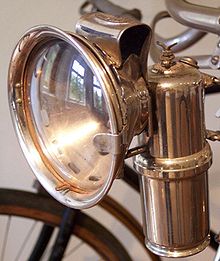| Revision as of 18:33, 2 June 2006 editAlan Canon (talk | contribs)Extended confirmed users2,832 edits Use in cave survey, etc.← Previous edit | Revision as of 11:20, 18 June 2006 edit undo69.119.20.136 (talk)No edit summaryNext edit → | ||
| Line 14: | Line 14: | ||
| Carbide lamps are favored for ], because the flame produces a soot which can be used to make non-toxic, removable marks on cave surfaces (often a small dot to indicate the location of a "survey station," with an alphanumeric label.) These markings will persist for many years if undisturbed, but can easily be wiped off. When carbide lamps are used for illuminating magnetic compasses in cave survey, it is important that the lamp and reflector not contain ferromagnetic metals which deflect the compass indicator. | Carbide lamps are favored for ], because the flame produces a soot which can be used to make non-toxic, removable marks on cave surfaces (often a small dot to indicate the location of a "survey station," with an alphanumeric label.) These markings will persist for many years if undisturbed, but can easily be wiped off. When carbide lamps are used for illuminating magnetic compasses in cave survey, it is important that the lamp and reflector not contain ferromagnetic metals which deflect the compass indicator. | ||
| Small carbide lamps called "Carbide Candles" are used for blackening rifle sights to reduce glare. These "candles" are used due to the sooty flame produced by acetylene. | |||
| The design of the lamp was first ]ed in ] on ], ] ({{US patent|711,871}}). | The design of the lamp was first ]ed in ] on ], ] ({{US patent|711,871}}). | ||
Revision as of 11:20, 18 June 2006

Carbide lamps (acetylene lamps) are simple lamps that produce and burn acetylene gas produced by reacting calcium carbide with water.
These lamps were formerly found in mines (not to be confused with the Davy lamp), vintage cars, and lighthouses; they are still sometimes used by cavers.
Pellets or chunks of calcium carbide (CaC2) are placed in the lower chamber (the generator). The upper chamber is then filled with water. A screw valve or other mechanism is used to control the rate at which the water is allowed to drip into the chamber containing the calcium carbide. By controlling the rate of water flow, the production of acetylene gas is controlled. This, in turn, controls the size of the flame (and thus the amount of light it produces).
The carbide lamp generally has a reflector behind the flame to redirect light in a more useful direction. A carbide lamp produces a surprisingly bright, broad light. Many cavers prefer this type of unfocused light as it improves peripheral vision in the completely dark environment.
The reaction of calcium carbide with water produces a fair amount of heat independent of the flame. In cold cave environments, carbide lamp users can use this heat to help stave off hypothermia.
When all of the carbide in a lamp has been reacted, the carbide chamber contains a wet paste of caustic lime (Calcium hydroxide. This is emptied into a waste bag and the chamber can be refilled. The residue is toxic to animals and should not be deposited in locations where animals may consume it. However, over time the hydroxide will react with atmospheric Carbon dioxide to form Calcium carbonate, which is non-toxic.
Carbide lamps are favored for cave survey, because the flame produces a soot which can be used to make non-toxic, removable marks on cave surfaces (often a small dot to indicate the location of a "survey station," with an alphanumeric label.) These markings will persist for many years if undisturbed, but can easily be wiped off. When carbide lamps are used for illuminating magnetic compasses in cave survey, it is important that the lamp and reflector not contain ferromagnetic metals which deflect the compass indicator.
Small carbide lamps called "Carbide Candles" are used for blackening rifle sights to reduce glare. These "candles" are used due to the sooty flame produced by acetylene.
The design of the lamp was first patented in Duluth, Minnesota on October 21, 1902 (U.S. patent 711,871).
See also
| Lighting | |||||||||||||
|---|---|---|---|---|---|---|---|---|---|---|---|---|---|
| Concepts | |||||||||||||
| Methods of generation |
| ||||||||||||
| Stationary | |||||||||||||
| Portable | |||||||||||||
| Automotive | |||||||||||||
| |||||||||||||
| |||||||||||||
| |||||||||||||
| Related topics | |||||||||||||
This technology-related article is a stub. You can help Misplaced Pages by expanding it. |